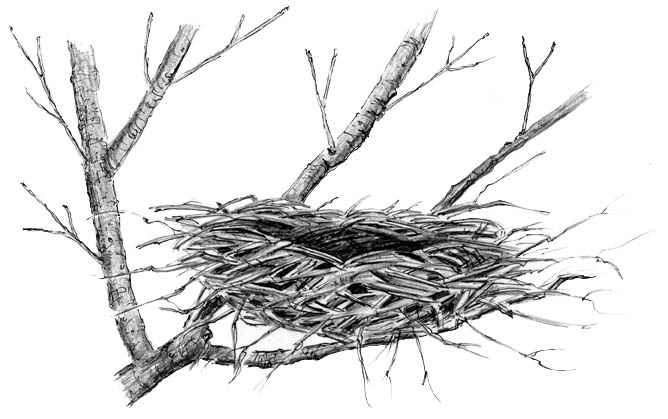
Dear Bird Folks,
Now that the leaves have fallen off the trees, I’ve discovered several intact bird’s nests around my yard. I believe one was a cardinal’s nest, another belonged to catbirds and another was a robin’s nest. Will these birds reuse their old nests next year? Will other birds use them? Finally, can they detect that a nest has been touched by human hands?
– Bob, Harwichport, MA
Fall is great, Bob,
It is the season of discovery. I used to think spring was the season of discovery. As the winter snowdrifts melted away I enjoyed finding the first crocuses, or daffodils, or the lawnmower that I forgot to put away last summer. But soon I learned that fall had much more to offer. When the leaves drop from the trees hidden treasures become exposed. So far this fall I have found an old kingbird’s nest clinging to a tiny tree in the middle of the Stop & Shop parking lot. I’ve also noticed several oriole nests. And high up in one tree in my yard I discovered a Blue Jay’s nest, a goldfinch nest, plus a lost Frisbee, and the lawnmower I forgot to use last summer.
It seems like it makes sense for birds to reuse the nest they built the year before. By simply claiming an old nest they could save themselves all that running around to gather ups building material. They also wouldn’t have the stress of getting their nest up and running before the eggs came popping out. The trouble is, like a good used toothbrush, good used nests are tough to find. This year’s nests may be “intact” right now, but by the time winter is done with them they’ll be in pretty bad shape. Nature has programmed most birds to build new each spring, but there are exceptions.
Of the three birds you mentioned, cardinals rarely use an old nest. Catbirds also build new nests each spring. Even if they have a second brood, they’ll still make an entirely new nest. There are probably too many memories associated with the old nest. Robins, on the other hand, do things a bit differently. Often they’ll build new, but sometimes they lay fresh eggs in a used nest and not think anything of it. Other times robins take an old nest and build a new one right on top of it. Apparently, they liked the location and the foundation, but not the floor plan.
The birds on your list, Bob, have the luxury of being able to nest in a variety of habitats. But other birds aren’t as flexible. Eastern Phoebes, for example, are in desperate need of covered ledges to build their nests on. When they return in the spring they often find many of the best spots are cluttered with nests from past years. Fortunately, these nests have been under cover all winter and may be in good shape. The phoebes just add a bit of fresh material and they are good to go. Even if the old nest has failed eggs or dead chicks remaining from the previous tenants, the phoebe will simply put another layer of material over the carnage and act as if nothing happened. With that in mind, if you ever visit a phoebe family, don’t look in the basement.
Then there are birds that have no special habitat requirements. These birds will nest just about anywhere. Well, they’ll nest anywhere if some other creature builds a nest for them. Great Horned Owls have the carpentry skills of a concert pianist and they know it. They won’t even try to build a nest. When it’s time for them lay their eggs, they simply look around for the nearest nest that meets their needs. Hawk, heron, crow, and even squirrel nests work just fine for them. Great-horns are the ultimate squatters and the former landlords don’t dare argue with these ferocious birds. There is no first and last months rent, no security deposit, and definitely no negotiation. The owls move right in and don’t do a thing to improve the property. By the time they have finished nesting, their “borrowed” property will be in pretty rough shape, and will probably be abandoned, or bought up by the government.
Although there are exceptions, on average most birds build new nests each year. Does that mean you can go out and gather any nests you find? No, it doesn’t mean that. Centuries of improper collecting have forced the government to pass laws that protect bird’s nests, as well as the birds themselves. Plus, even unused nests can be beneficial, as some of the more socially conscious birds will recycle parts of old nests the following spring. You know those birds. They are the ones with the beads, beards, and ponytails.
In the last part of your question, Bob, you wondered if birds could tell that a nest has been touched by human hands. Next to “Don’t run with scissors” and “Don’t stick your tongue in the fan” (my house only), the most commonly remembered rule taught by mothers is “Don’t touch bird nests or the birds will smell you and abandon the nest.” The short answer to that is: Touch the nest all you want. A songbird’s sense of smell isn’t very acute. That means no matter how bad your cologne may smell they’ll never know it. Birds are so lucky.